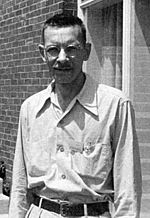Alfred Hershey facts for kids
Quick facts for kids
Alfred Hershey
|
|
|---|---|

Alfred D. Hershey in 1969
|
|
| Born | December 4, 1908 Owosso, Michigan
|
| Died | May 22, 1997 |
| Nationality | United States |
| Alma mater | Michigan State University |
| Known for | bacteriophages |
| Awards | Nobel Prize in Physiology or Medicine 1969 |
| Scientific career | |
| Fields | bacteriology genetics |
Alfred Day Hershey (December 4, 1908 – May 22, 1997) was an American Nobel Prize-winning bacteriologist and geneticist.
He was born in Owosso, Michigan and received his B.S. in chemistry at Michigan State University in 1930 and his Ph.D. in bacteriology in 1934, taking a position shortly thereafter at the Department of Bacteriology at Washington University in St. Louis.
He began doing experiments with bacteriophages with Italian-American Salvador Luria and German Max Delbrück in 1940. He found that when two different strains of bacteriophage have infected the same bacteria, the two viruses may exchange genetic information.
He moved with his wife Harriet to Cold Spring Harbor, New York, in 1950 to join the Carnegie Institution for Science's Department of Genetics. There he performed the famous Hershey-Chase blender experiment with Martha Chase in 1952. This experiment provided additional evidence that DNA, not protein, was the genetic material.
He became director of the Carnegie Institution in 1962 and was awarded the Nobel Prize in Physiology or Medicine in 1969, shared with Luria and Delbrück for their discovery on the replication of viruses and their genetic structure.
See also
 In Spanish: Alfred Day Hershey para niños
In Spanish: Alfred Day Hershey para niños

